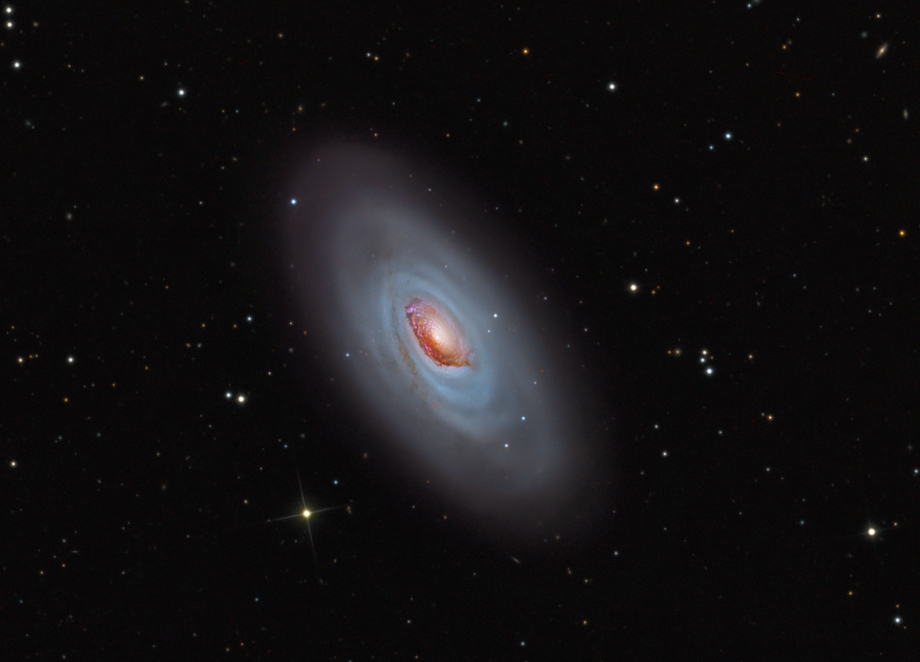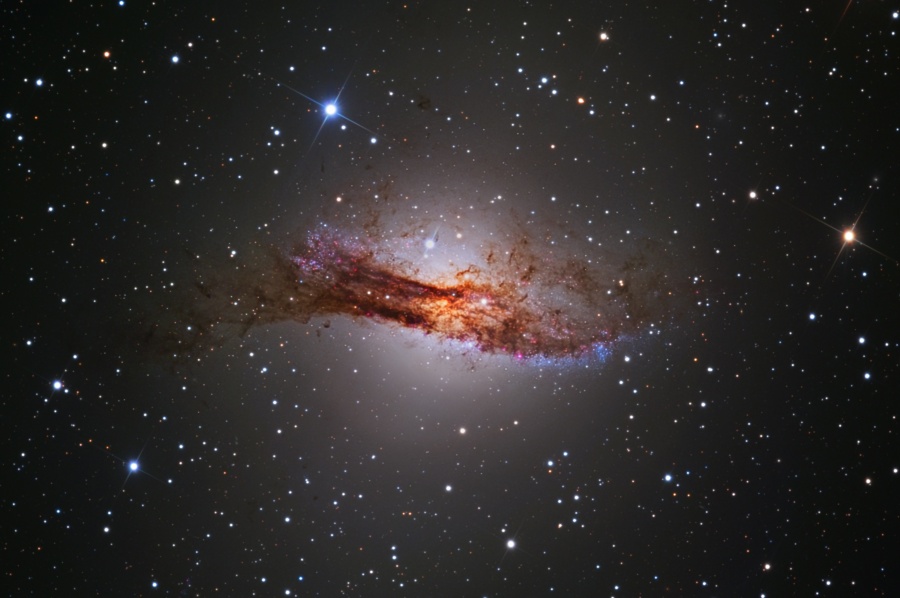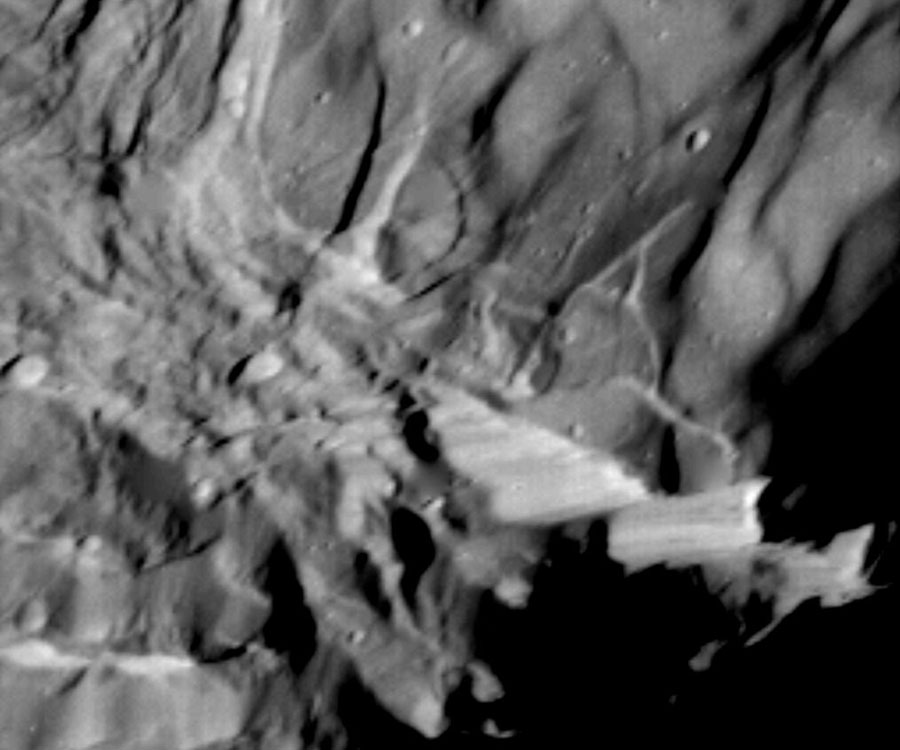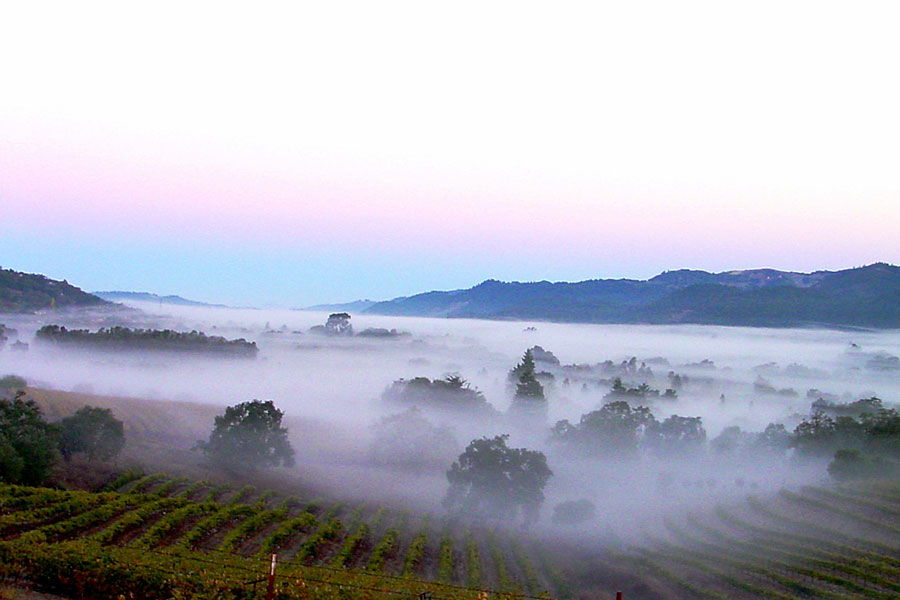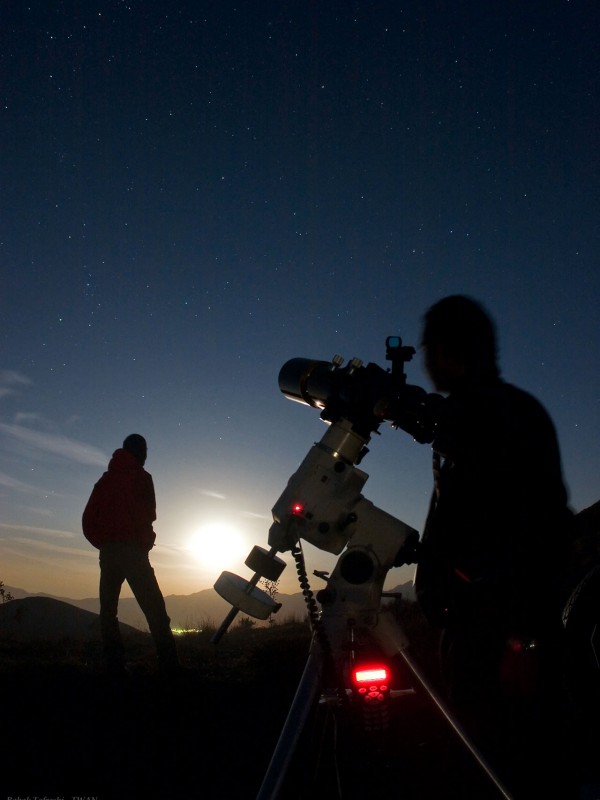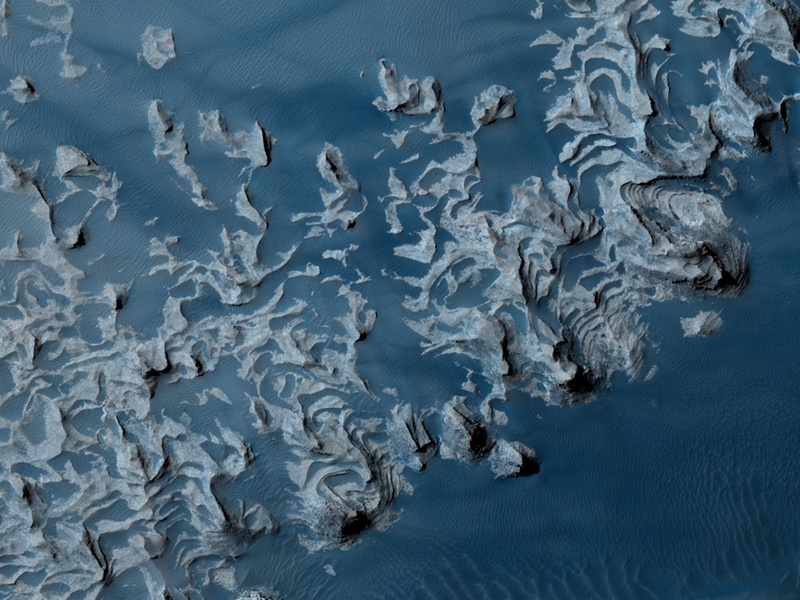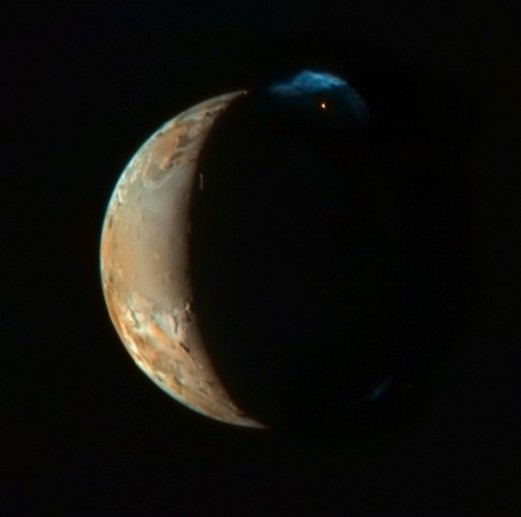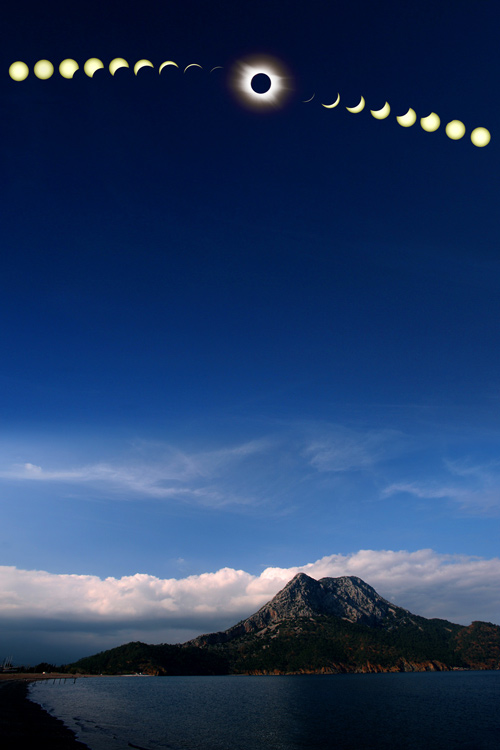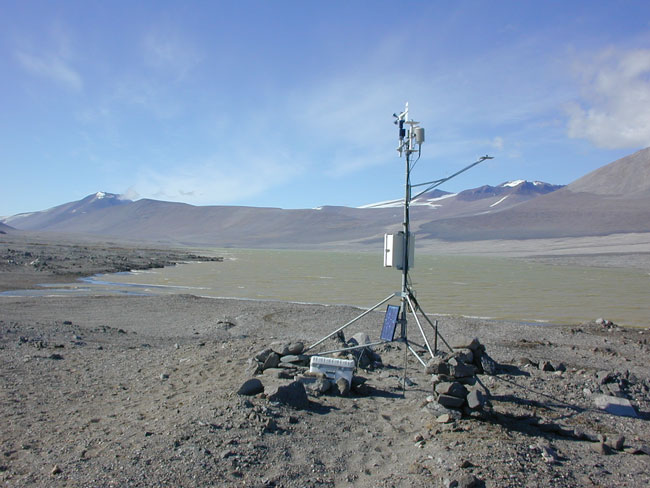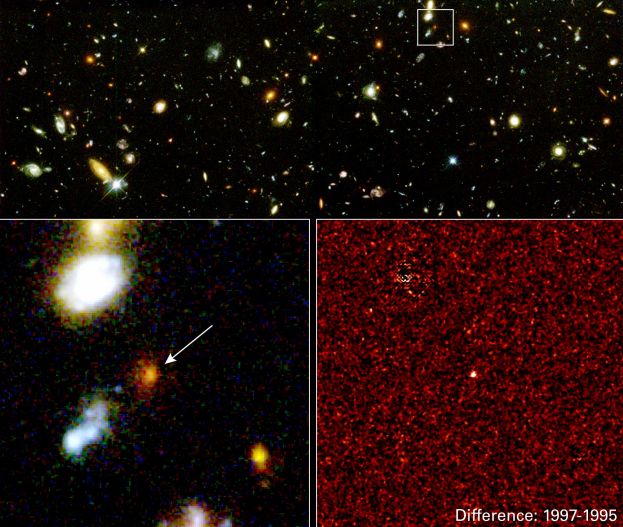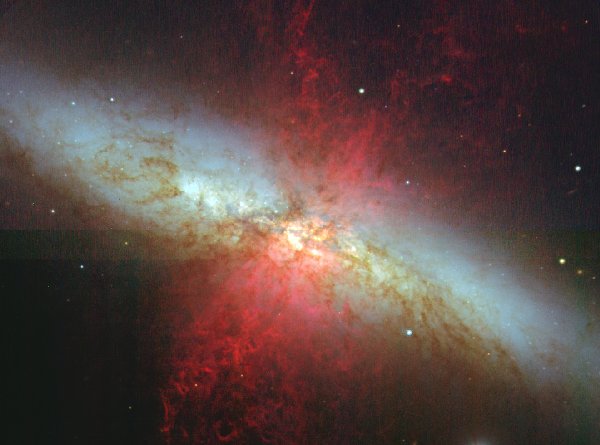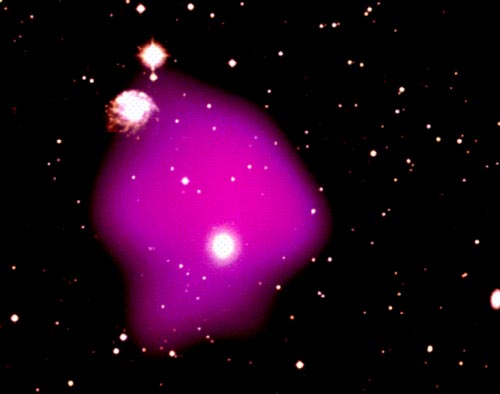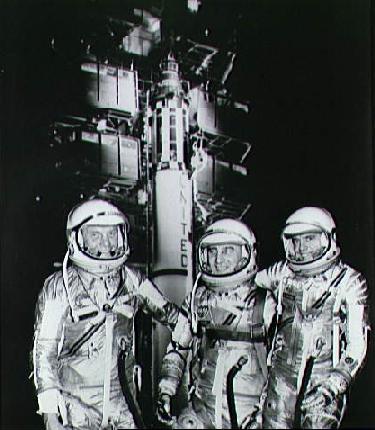| << Previous | Index | Next >> |
2015 Mysterious Hanny's Voorwerp, Dutch for "Hanny's Object", is really enormous, about the size of the Milky Way Galaxy and glowing strongly in the greenish light produced by ionized oxygen atoms. It is thought to be a tidal tail of material left by an ancient galaxy merger, illuminated and ionized by the outburst of a quasar inhabiting the center of distant spiral galaxy IC 2497. Its exciting 2007 discovery by Dutch schoolteacher Hanny van Arkel while participating online in the Galaxy Zoo project has since inspired a search and discovery of eight more eerie green cosmic features. Imaged in these panels by the Hubble Space Telescope, all eight appear near galaxies with energetic cores. Far outside their associated galaxies, these objects are also likely echoes of quasar activity, illuminated only as light from a core quasar outburst reaches them and ultimately fading tens of thousands of years after the quasar outburst itself has faded away. Of course a galaxy merger like the impending merger of our own Milky Way and the Andromeda Galaxy, could also trigger the birth of a quasar that would illuminate our distant future version of Hanny's Voorwerp.
2014 Delicate in appearance, these filaments of shocked, glowing gas, draped in planet Earth's sky toward the constellation of Cygnus, make up the western part of the Veil Nebula. The Veil Nebula itself is a large supernova remnant, an expanding cloud born of the death explosion of a massive star. Light from the original supernova explosion likely reached Earth over 5,000 years ago. Blasted out in the cataclysmic event, the interstellar shock wave plows through space sweeping up and exciting interstellar material. The glowing filaments are really more like long ripples in a sheet seen almost edge on, remarkably well separated into atomic hydrogen (red) and oxygen (blue-green) gas. Also known as the Cygnus Loop, the Veil Nebula now spans nearly 3 degrees or about 6 times the diameter of the full Moon. While that translates to over 70 light-years at its estimated distance of 1,500 light-years, this wide image of the western portion spans about half that distance. Brighter parts of the western Veil are recognized as separate nebulae, including The Witch's Broom (NGC 6960) along the top of this view and Pickering's Triangle (NGC 6979) below and right of center.
2013 This beautiful, bright, spiral galaxy is Messier 64, often called the Black Eye Galaxy or the Sleeping Beauty Galaxy for its heavy-lidded appearance in telescopic views. M64 is about 17 million light-years distant in the otherwise well-groomed northern constellation Coma Berenices. In fact, the Red Eye Galaxy might also be an appropriate moniker in this colorful composition of narrow and wideband images. The enormous dust clouds obscuring the near-side of M64's central region are laced with the telltale reddish glow of hydrogen associated with star forming regions. But they are not this galaxy's only peculiar feature. Observations show that M64 is actually composed of two concentric, counter-rotating systems of stars, one in the inner 3,000 light-years and another extending to about 40,000 light-years and rotating in the opposite direction. The dusty eye and bizarre rotation is likely the result of a billion year old merger of two different galaxies.
2012
2011 Could you survive a jump off the tallest cliff in the Solar System? Quite possibly. Verona Rupes on Uranus' moon Miranda is estimated to be 20 kilometers deep -- ten times the depth of the Earth's Grand Canyon. Given Miranda's low gravity, it would take about 12 minutes for a thrill-seeking adventurer to fall from the top, reaching the bottom at the speed of a racecar -- about 200 kilometers per hour. Even so, the fall might be survivable given proper airbag protection. The above image of Verona Rupes was captured by the passing Voyager 2 robotic spacecraft in 1986. How the giant cliff was created remains unknown, but is possibly related to a large impact or tectonic surface motion.
2010 Although you've surely seen it, you might not have noticed it. During a cloudless twilight, just before sunrise or after sunset, part of the atmosphere above the horizon appears slightly off-color, slightly pink. Called the Belt of Venus, this off-color band between the dark eclipsed sky and the blue sky can be seen in nearly every direction including that opposite the Sun. Straight above, blue sky is normal sunlight reflecting off the atmosphere. In the Belt of Venus, however, the atmosphere reflects light from the setting (or rising) Sun which appears more red. The Belt of Venus can be seen from any location with a clear horizon. Pictured above, the Belt of Venus was photographed above morning fog in the Valley of the Moon, a famous wine-producing region in northern California, USA. The belt is frequently caught by accident in other photographs.
2009 As twilight sweeps around planet Earth tonight (April 4), many amateur astronomers will set up their telescopes for a 24-hour global star party. The planetwide star party is part of 100 Hours of Astronomy (100HA), a project of the International Year of Astronomy 2009. To join the party, members of the public can find a nearby organized event or planned webcast by consulting the schedules on the 100HA website. What could you see through a telescope tonight? For starters, a bright Moon will shine in the evening sky, offering telescopic observers spectacular views of impact craters, mountains, and lava-flooded mare. Tonight's other celestial targets include the crowd pleasing planet Saturn surrounded by its own moons, its rings tilted nearly edge-on.
2008 At first glance these undulating shapes in shades of blue might look like waves on an ocean. Seen here in a false-color image from the Mars Reconnaissance Orbiter's HiRISE camera, they are actually layered rock outcrops found in Aureum Chaos. The larger Aureum Chaos region is a chaotic jumble of eroded terrain in the eastern part of Mars' immense canyon Valles Marineris. Distinct layers composing these outcrops could have been laid down by dust or volcanic ash settling from the atmosphere, sand carried by martian winds, or sediments deposited on the floor of an ancient lake. This close-up view of the otherwise red planet spans about 4 kilometers, a distance you might walk over flat ground in less than an hour.
2007 Spewed from a volcano, a complex plume rises over 300 kilometers above the horizon of Jupiter's moon Io in this image from cameras onboard the New Horizons spacecraft. The volcano, Tvashtar, is marked by the bright glow (about 1 o'clock) at the moon's edge, beyond the terminator or night/day shadow line. The shadow of Io cuts across the plume itself. Also capturing stunning details on the dayside surface, the high resolution image was recorded when the spacecraft was 2.3 million kilometers from Io. Later it was combined with lower resolution color data by astro-imager Sean Walker to produce this sharp portrait of the solar system's most active moon. Outward bound at almost 23 kilometers per second, the New Horizons spacecraft should cross the orbit of Saturn in June next year, and is ultimately destined to encounter Pluto in 2015.
2006 Some views of last week's total eclipse of the Sun were better than others. One spectacular view occurred over Adrasan (near Antalya), Turkey and was captured there by industrious astrophotographer Stefan Seip. The above digital mosaic caught the Moon in several stages as it moved between the Earth and the Sun. During the center frame, a total solar eclipse was visible, the Moon completely blocked the Sun, the area became dark, and the magnificent corona of the Sun became visible. The foreground frame from the same location was taken during sunlight. The next total eclipse of the Sun will occur in August 2008 and be visible from parts of North America, Europe, and Asia.
2005 How did this strange-looking galaxy form? Astronomers turn detectives when trying to figure out the cause of unusual jumbles of stars, gas, and dust like NGC 1316. A preliminary inspection indicates that NGC 1316 is an enormous elliptical galaxy that includes dark dust lanes usually found in a spiral. The above image taken by the Hubble Space Telescope shows details, however, that help in reconstructing the history of this gigantic jumble. Close inspection finds fewer low mass globular clusters of stars toward NGC 1316's center. Such an effect is expected in galaxies that have undergone collisions or merging with other galaxies in the past few billion years. After such collisions, many star clusters would be destroyed in the dense galactic center. The dark knots and lanes of dust indicate that one or more of the devoured galaxies were spiral galaxies. NGC 1316 spans about 60,000 light years and lies about 75 million light years away toward the constellation of the Furnace.
2004 A lake hidden beneath 19 meters of ice and gravel has been found near the bottom of the world that might contain an ecosystem completely separate from our own. In a modern version of Sir Arthur Conan Doyle's classic book Lost World, NASA funded scientists are now plotting a mission to drill down into the lake and remove a sample of water from the lake for analysis. Lake Vida, buried under Antarctic ice for over 2,500 years, is liquid only because of a high salt content that results from salt being expelled from water above as it turns to ice. Previously, scientists drilled to within a few meters of the lake and indeed found frozen microbes. Their existence bolsters speculation that similar microorganisms could be found in frozen brine beneath the surface of Mars. If living organisms are found in Lake Vida, they may give an indication that life might even still exist under similar frozen ice-sheets, such as under the larger Lake Vostok, parts of Mars, and even moons of Jupiter such as Europa. Pictured above, a robot meteorological station continues to monitor surface conditions over the ice-sealed lake.
2003
[imghover6=http://apod.nasa.gov/apod/image/0304/he ... linger.jpg]http://apod.nasa.gov/apod/image/0304/he ... abeled.jpg[/imghover6]Credit & Copyright: Axel Mellinger
2002 Comet Ikeya-Zhang ("ee-KAY-uh JONG") has become a most photogenic comet. This lovely early evening view of the comet in Rocky Mountain skies looks northwest over ridges and low clouds. The time exposure was recorded on March 31st from an 8,000 foot elevation near Yampa, Colorado, USA. Sporting a sweeping yellowish dust tail and blue ion tail eight to ten degrees long, Ikeya-Zhang is nestled near the horizon in the northern constellation of Andromeda. To the comet's left is the bright star Mirach or Beta Andromedae while the stretched celestial fuzzball to the comet's right is M31 or the Andromeda galaxy, the nearest bright spiral galaxy to our own Milky Way. As the days pass, Comet Ikeya-Zhang's apparent motion through the sky is towards the right in this image. Tonight, comet-watchers blessed with clear skies should find Ikeya-Zhang posing perfectly for binoculars and cameras just above M31, less than two degrees from the center of the bright galaxy.
2001 A pinpoint of light from a star that exploded over 10 billion light-years away is centered in the panel at the lower right, a cosmic snapshot of the most distant supernova. The ancient stellar detonation was detected by digitally subtracting before and after images of a faint, yellowish, elliptical galaxy included in the Hubble Space Telescope Deep Field image illustrated at the top and left. Remarkable in itself as the farthest known supernova, its measured brightness provides astounding evidence for a strange universe - one which eventually defies gravity and expands at an accelerating rate. The unseen force driving this expansion is attributed to "dark energy" and discovering the fundamental nature of dark energy has been called the challenge of this millennium.
2000 What's lighting up the Cigar Galaxy? M82, as this irregular galaxy is also known, was stirred up by a recent pass near large spiral galaxy M81. This doesn't fully explain the source of the red-glowing outwardly expanding gas, however. Recent evidence indicates that this gas is being driven out by the combined emerging particle winds of many stars, together creating a galactic "superwind." The above recently released photograph from the new Subaru Telescope highlights the specific color of red light strongly emitted by ionized hydrogen gas, showing detailed filaments of this gas. The filaments extend for over 10,000 light years. The 12-million light-year distant Cigar Galaxy is the brightest galaxy in the sky in infrared light, and can be seen in visible light with a small telescope towards the constellation of Ursa Major.
1999 Is the gravity of the galaxies seen in this image high enough to contain the glowing hot gas? Superposed on an optical picture of a group of galaxies is an image taken in X-ray light. This picture, taken by ROSAT, shows confined hot gas highlighted in false red color, and provides clear evidence that the gravity exerted in groups and clusters of galaxies exceeds all the individual component galaxies combined. The extra gravity is attributed to dark matter, the nature and abundance of which is one of the biggest mysteries in astronomy today.
1998 Space suited project Mercury astronauts John H. Glenn, Virgil I. Grissom, and Alan B. Shepard Jr. (left to right) are posing in front of a Redstone rocket in this vintage 1961 NASA publicity photo. Project Mercury was the first U.S. program designed to put humans in space. It resulted in 6 flights using one-man capsules and Redstone and Atlas rockets. Shortly after the first U.S. manned flight on May 5, 1961, a suborbital flight piloted by Alan Shepard, President Kennedy announced the goal of a manned lunar landing by 1970. This goal was achieved by NASA's Apollo program and Shepard himself walked on the moon as commander of the Apollo 14 mission. Virgil Grissom died in a tragic fire during an Apollo launch pad test in 1967. Senator John Glenn will fly again on the 25th voyage of the Space Shuttle Discovery.
1997 This stereo pair of Hale-Bopp images combines two pictures from slightly different viewing angles. Simulating stereo vision, the difference was generated by the comet's apparent motion as it cruised through the inner Solar System. The camera was located in the Shoshone National Forest, Wyoming, USA, Planet Earth, and the two pictures were taken about 45 minutes apart on March 25. Digitized versions were then carefully cropped and adjusted so that the background stars matched. The product of an internet collaboration between J. Modjallal and M. Frost, this pair is meant to be viewed from a comfortable distance by gently crossing your eyes until the images merge.
1996
| << Previous | Index | Next >> |


